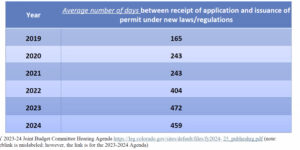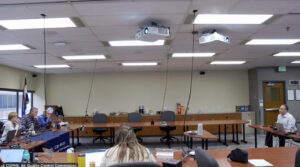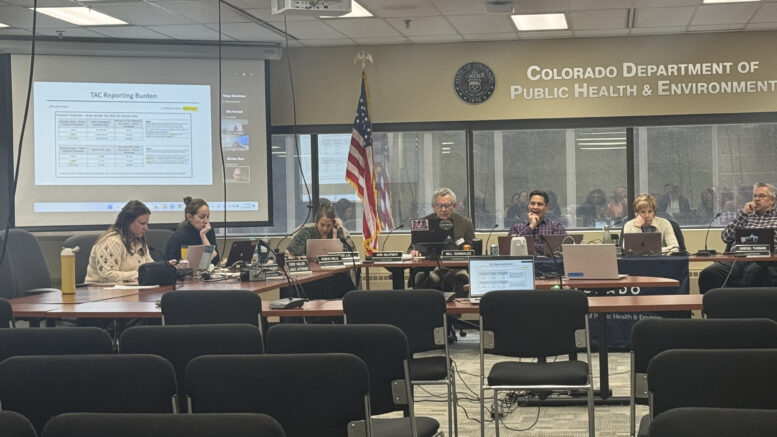A Colorado regulatory panel agreed Friday to raise fees on industrial companies by as much as 67% and to implement a new system, beginning in 2027, under which those firms must report even small levels of emissions for 342 different toxic air contaminants.
The changes are required by a law passed in 2022 to identify and regulate a wide swath of health-affecting air contaminants, expanding the state’s efforts beyond the greenhouse-gas emissions on which Colorado officials have concentrated efforts for a decade. By tracking the amount of all these contaminants in the air, state officials believe they can pinpoint those that are the most problematic and can begin by 2029 to impose new restrictions on the ones they feel are harming public wellness the most.
Colorado Air Quality Control Commission members first identified five high-priority toxic air contaminants in January for which they’ll impose health-based standards later this year — formaldehyde, benzene, hexavalent chromium, ethylene oxide and hydrogen sulfide. But with this week’s rulemaking, they laid the groundwork for officials to identify more priority TACs when the law allows them to go beyond the first five in 2029 and to get more resources to carry out air-quality programs.
This new rule will boost the annual emission fee for criteria air pollutants to $60 per ton and the annual emissions fee for hazardous air pollutants to $398 per ton — both 66.5% increases. It also raises the cost of Air Pollution Emission Notices to $363 per filing and permit processing fees to $180 per hour — both 50% increases.
While the fee increases are the largest in memory, at least percentagewise, business leaders said they would not fight them because they understand the funding is needed to keep programs in the Colorado Department of Public Health and Environment running.
More concern over permit delays than emissions fees

A graphic from the Colorado Chamber of Commerce shows the increase in the amount of time since 2019 that it takes the Colorado Air Pollution Control Division to process permit applications.
However, groups such as the Colorado Chamber of Commerce, American Petroleum Institute Colorado and Colorado Utilities Coalition said they want the division to meet new performance standards focused on speeding permit review.
The average number of days between submission of permit applications and issuance of permits by CDPHE has risen by nearly 2-1/2 times, from 165 days in 2019 to 459 days in 2024, according to data that the state provided to the Joint Budget Committee. At the same time, addition and expansion of fees on the operations of emitters means Colorado businesses will be paying $12,738 per ton of volatile organic compounds and nitrous oxides by 2028, said Christy Woodward, Colorado Chamber regulatory affairs advisor.
Kristen Derr, an environmental specialist for pipeline company Williams, said her company filed an application to upgrade a compressor station in 2022 — and waited 13 months for it to even get assigned to a permit reviewer before taking another 15 months to get approved. Julia Griffin, senior air permitting and compliance specialist with Kinder Morgan, described a permit application she filed to reduce fugitive emissions in March 2024 and noted that CDPHE has spent 308 hours on it and billed her $43,000 but hasn’t awarded a permit yet.
With all the issues CDPHE has had in permitting efficiency, industry leaders asked for it to restart a committee of permittees to provide feedback on the process and report performance metrics by 2027 to show that it’s considering applications more quickly. They noted this increase in delays has occurred even after the department’s Air Pollution Control Division got about 100 more employees through the budget process in 2022.
AQCC requires more accountability from staff
“We need the division to issue permits faster and to make this process more efficient,” said Chris Colclasure, an attorney with Beatty & Wozniak representing the Colorado Oil & Gas Association.

Chris Colclasure, an attorney representing the Colorado Oil & Gas Association, answers questions Friday from the Colorado Air Quality Control Commission.
Commissioner Martha Rudolph, a former director of environmental programs for CDPHE, agree that she was “alarmed” by the fact that it now takes an average of more than 16 months to issue permits, and she agreed that APCD needs to be held accountable. So, she persuaded fellow AQCC members to add a requirement to the fee increase that the division implement efficiency programs to reduce permit and modeling processing timelines and report back to the commission on progress.
APCD officials pushed back on proposals that they should implement full performance management systems to ensure an increase in permitting efficiency, saying that would divert important resources away from existing efforts. But they said they felt they answered business concerns by agreeing to start providing more frequent updates on permitting times, permit backlog totals and progress on modernizing and digitizing a permitting system that’s long required paper forms.
“We agree that permit process times aren’t where we want them to be,” said Jessica Ferko, APCD planning and policy program manager. “And despite permit processing times not being the focus of this rulemaking, or arguably within the scope of the rulemaking, we have engaged extensively with parties on this topic.”
Reporting rules also an issue
Commissioners also pushed back implementation of the new fees from July to January, noting that it would have been unfair to require emitters who get their annual bills in the second half of the year rather than the first half to have to pay the higher costs. However, it approved a one-year increase in the two emission fees in 2026 to make up for what otherwise would have been a $1.7 million loss to APCD because of the delay.

Christy Woodward is the regulatory affairs advisor for the Colorado Chamber of Commerce
Despite the changes, industry leaders said the impact of the fees will be felt beyond just the corporate boardroom. Officials with the Colorado Utilities Coalition noted the new fees could cost more than $300,000 a year for large electricity providers — expense hikes that they will seek to pass along to customers in future rate cases.
In addition to raising fees, the AQCC approved rules for how private companies and a few public entities (such as Denver International Airport) must begin reporting their emissions on the 342 identified toxic air contaminants from stationary sources. Those rules, which exclude reporting on mobile sources like vehicles, increase the frequency of reporting on many TACs from every five years to annually, expand who must report and set de minimis levels of emissions above which all parties must report.
Defining de minimis emissions levels
Business leaders worried about de minimis levels that many called “very conservative” — and worried that such low levels of required reporting would be copied and pasted as maximum levels of emissions when the AQCC develops health-based standards for TACs. APCD staffers seemed to alleviate some of those concerns by offering language clarifying that the reporting levels are entirely separate from the coming health-based standards.
Industry leaders noted that they’ll still have to use more resources estimating and measuring emissions —even when those emissions fall beneath de minimis levels that they won’t have to report. They must report the first toxic-air-contaminant measurements by June 2027 on a reporting system that APCD is just developing, and several called the amount of new reporting burdensome, especially without a definitive plan on how the information that is gained from it will be used.
“Simply asking for everything because you don’t know what is out there is like using a magnifying glass to inspect every grain of sand on a beach, expecting you will find a diamond,” Woodward said.
“A difficult rulemaking”

Colorado Air Quality Control Commission member Curtis Rueter speaks during a hybrid AQCC meeting on Friday.
Members of the Local Government Coalition representing Adams, Boulder and Broomfield counties wanted more — specifically, reporting on ultra fine particles and black carbon, both of which come from multiple sources and can impact health. AQCC members compromised and added those contaminants to the list of TACs that can be considered for increased regulation in four years but did not require companies to report specifically on measurements for their them, as there are not reliable ways to estimate that yet.
With the final vote, emitters now have a guidepost for what they must measure and how they must report it, and they have two years to prepare to submit reports. State regulators then will have two full years to evaluate the information they are getting on 342 more toxic air contaminants in order to decide what further rules they must put into place.
“This has been a long process and a difficult rulemaking,” AQCC member Curtis Rueter said before the commission approved the new rules unanimously. “But I think folks brought forward a lot of good suggestions, and we ended up in a very good place.”
